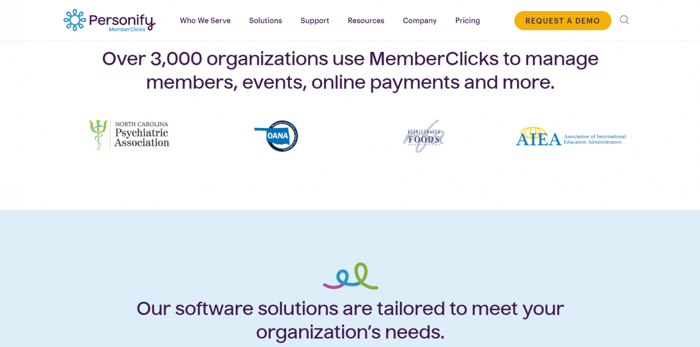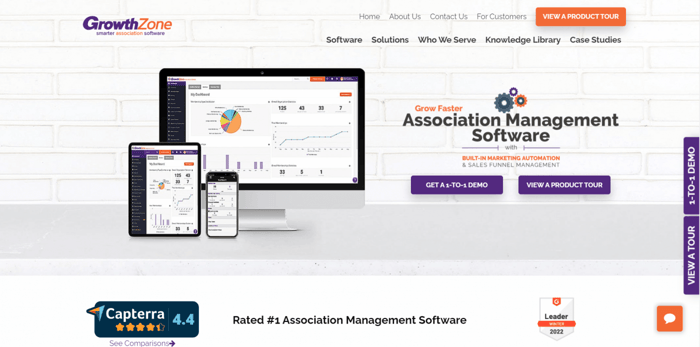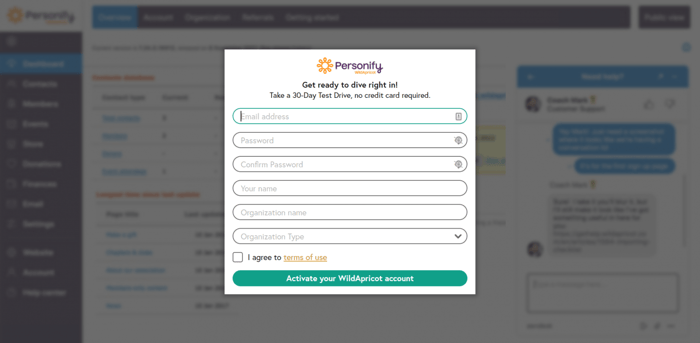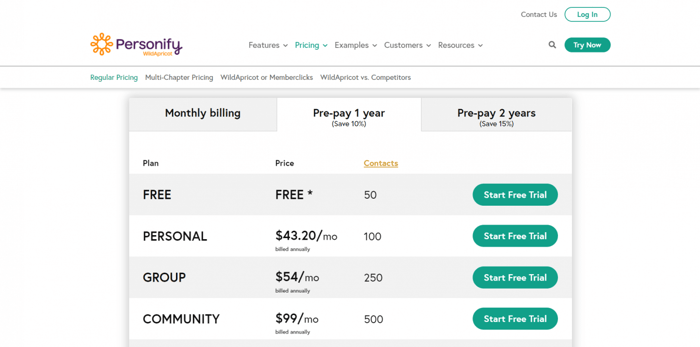In this association management software website builder comparison, we’ll explore the key differences between an association management platform like WildApricot and a standard site builder platform like Squarespace, for instance.
Right off the bat, you might ask, why do we even need a comparison of this type? The reason is that they do have a lot of similar features.

The confusion over association management software (AMS) and website builders usually arises from the fact that AMS solutions normally include the ability to build a website, just like standard site builders.
So, can’t you just build a website on one of the popular site builder platforms and manage your association venture from there? Why use association management software at all? More importantly, if they’re not interchangeable with each other, in what contexts would you use one rather than the other?

In this article, we’ll address all these and other similar questions. We’ll start by looking at what association management software is, and we’ll see exactly how it differs from a classic site builder solution.
In addition to this, we’ll show you a list of some of the best association management platforms and give specific examples of how a few of them work. By the end, you’ll know the differences between association management apps and website builders, as well as the contexts in which either option is more appropriate. So, without further ado, let’s begin our comparison.
Table of Contents
What Is Association Management Software?
To answer the question of what association management software is, first, we need to clarify what an association is.
Associations assemble people with common interests around a single main objective or cause. The following are common examples of associations:
- Clubs
- Institutes
- Guilds
- Cooperatives
- Unions
- Educational institutions
- Economic groups
- Political organizations
- Professional societies (doctors, writers, artists, etc.)
- Fellowships
Despite the many different types of associations, we can argue that the two main and most general categories are for-profit and nonprofit associations. The purpose of association management software is to enable all types of associations to promote their interests and fulfill their mission, goals, and objectives.
Association Management Platforms
Association management platforms are web-based software solutions that allow associations to manage their day-to-day activities in an efficient and – as much as possible – hassle-free way.
A good association management platform would usually be a robust software solution that consists of multiple modules, components, or functionalities. Some of the most frequently encountered modules that association management platforms include are the following:
- Membership management
- Contact database
- Website and CMS
- Email and communication
- Event management
- Payment processing
As a rule, an AMS platform will offer multiple pricing plans/accounts and a free trial to test-drive the software. Of course, this would depend on the platform, but it’s not uncommon for an association management platform to offer a completely free plan.
As far as the paid plans are concerned, they usually cover everything – from features for associations that are just starting out online to ones for large enterprise-level organizations.
Website Builders
When you look at popular website creation platforms, such as Wix, Webflow, Weebly, Duda, and the one we mentioned earlier, Squarespace, it’s quite obvious from their features and functionality that they all revolve around site creation.
They may include e-commerce functionality, a blog along with a more or less elaborate content management system, payment processing systems, and so on, but website building is at the core of it all.
That is why website builders generally offer a lot more templates/themes and customization domains than the association manager platforms. As websites are their focal point, site builders invest a lot more in design and functionalities strictly related to creating and running a standard website.

A typical website builder enables you to create a standard website around which everything else revolves. Chances are the majority of the websites you have visited belong to this category.
The home page is the most recognizable component of a standard website. In fact, the images we showed in the introductory part of this article are the homepage examples of the WildApricot and Squarespace official websites.
Needless to say, standard websites can include a ton of other types of pages, but typically, the home page is the one that we associate with a specific company or web platform. Usually, it contains buttons and links in the footer and a navigation menu in the header that leads you to other site pages.
The Difference Between Website Builders and Association Management Platforms
| A quick comparison: | ||
| Website builders | Association management platforms | |
| Core purpose | Develop and edit websites | Support the day-to-day management of an association |
| Key features |
|
|
Unlike site builders, we can hardly say that association management platforms revolve around a website. Instead, their primary role is to provide specialized functionality to support associations of all types.
It would be impossible to manage an association without robust database functionality, advanced membership management tools, and the ability to accept all sorts of payments (including offline and direct bank payments as well as donations).
Likewise, it would be nearly impossible to run your day-to-day operations without a solid email or text message automation system in place and sophisticated event management tools. In that sense, association management platforms are – to a certain extent – an all-in-one package for associations.
We could argue that all modules play equally important roles in an association management platform. It’s no use if you’re a nonprofit and can build a website but cannot accept donations or start a fundraising campaign because a payment system is missing. Similarly, what would the point of a website be if you didn’t have access to database functionality to manage memberships?

Finally, a website you build on an AMS platform differs from a standard website. On a platform like this, you usually create membership websites. How are they different from the standard websites built with a website builder?
The fundamental difference is that they include gated or protected content hidden behind a paywall. In addition to this, they usually contain a membership application form and an event management system. The event management page provides information on your organized events and gives users opportunities to register and benefit from them.
Association Management Software Examples
Let’s now take a look at the most popular association management platforms out there. That way, you’ll gain an even better picture of what an association management platform is and how it works.
The following five platforms are some of the most popular association management software available today.
WildApricot
WildApricot is one of the most widely known association management and membership software solutions. The platform is used by groups like the Florida State Parks Foundation, Georgia Science Teachers Association, and the Australian Association of Graduate Employers. It offers the following features and functionality:
- 30-day free trial
- Eight pricing plans, one free and the rest paid, going from $60 up to $900 per month
- Drag-and-drop site editor
- Native blog
- Cloud-based “organized searchable database”
- Automated application process
- Automated email responses
- Its own payment system
- Sophisticated event calendar
- Online store
MemberPlanet

We have to say that association management platforms are typically quite similar, so there’s a huge overlap in the features and tools they offer. The differences are usually very subtle, but you can read our thorough comparison of WildApricot and MemberPlanet.
Nevertheless, here are some of the defining features offered by MemberPlanet:
- A free trial
- One free account, three paid plans with prices ranging from $50 to $175 per month, and a custom enterprise-level offering
- Simplified and easy onboarding process
- Customizable online database
- Native payment system
- Multiple payment options
- Branded event pages
- Peer-to-peer fundraising
- Optimal time email and text message scheduling
- Customizable reporting that gives you insight into stats related to donations, payments, and events
MemberClicks
Like the previous two platforms, MemberClicks is also a cloud- and web-based association management software.
MemberClicks and WildApricot were both acquired by Personify in 2020 and 2017, respectively. However, they kept their different identities and continued to function as different platforms to a certain extent.
For instance, while WildApricot caters to a wide range of member-driven organizations, MemberClicks seems to be primarily geared toward large, professional associations. More specifically, the platform serves trade associations, chambers of commerce, and association management companies.

MemberClicks provides its customers with tons of valuable tools and features, some of which are the following:
- Two annual pricing plans with the lowest upfront annual fee being $3,500 “for the smallest organizations.”
- Website functionality that includes SEO tools, widgets, a sponsor ads manager, and more.
- Event management module that includes the ability to set up payment method fees, manage event attendees, create promo codes, follow different event-related stats, and a myriad of more helpful features.
- Database management functionality that allows you to take care of membership renewals and invoices, set different permission levels, and do a host of other things.
- Learning management system that allows you to launch courses.
- Multiple payment gateway integration options, such as PayPal, Authorize.Net, Beanstream, CardPointe, and Payroc.
- Automated email receipts and recurrent emails.
- CMS and blogging functionality.
- Donation form builder.
- Membership analytics.
GrowthZone
GrowthZone exclusively targets associations, so in a way, it’s the best example of association management software. However, this does not mean that the platform has functionalities that are hard to find on other platforms.
Since GrowthZone was built exclusively with associations in mind, it means that your experience with this platform would probably differ a bit from your experience of more generic membership platforms.

The feature set of GrowthZone includes:
- Three standard pricing plans with prices ranging from $259 to $579 per month, one custom enterprise offering, and a free trial.
- Member management module that allows you to set different membership offers, streamlined online membership applications, automatic and manual membership approval, and overdue membership cancellation.
- Searchable database.
- Native payment system called GrowthZone Pay – tailored specially for associations that allows you to receive payments from credit and debit cards as well as US-based bank accounts.
- Custom website built by the GrowthZone team exclusively for your association along with the possibility to choose from one of the pre-built designs.
- Data migration that allows you to import your contacts and data from another platform to GrowthPoint.
- Event management system that includes email invitations, event pages, online registration, and event reports.
- Email scheduling and tracking.
- Fundraising campaigns along with reports on your campaigns.
- Online store.
Member365
Similar to WildApricot, Member365 is a more generic membership platform. It’s all-in-one membership management software, meaning that it strives to cater to other types of organizations as well as associations.

Member365 offers the following tools and features:
- Three pricing plans that start from $279/month and go up to $479/month.
- A 30-day free trial that doesn’t require your credit card information.
- Automated membership operations, application forms, and group membership.
- Ability to organize webinars, conferences, and any type of event, track numbers related to your events.
- Ability to allow non-members to sign up for an event.
- Email templates, email campaigns, email lists of contacts who can self-subscribe, and a host of other helpful email-related features.
- Member portal that allows members to download membership receipts, renew their membership, and view upcoming events.
- Integrated learning management system that allows users to create courses, tutorials, and training.
- Ability to process online and offline payments made in cash, credit cards, and checks.
- Online store that allows you to sell physical goods (for instance, clothes and artwork) and digital goods (e.g., training).
- Fundraising campaigns, donations, and fundraising-related analytics.
- Surveys that give you invaluable information on what members think about your association, thus helping you to improve your service and offerings.
How to Choose Association Management Software
In this section, we’ll give you a few tips on what you should pay attention to when looking for an association management software solution. Let’s go with the first one.
Customer Reviews
Before you decide what to do and which association management platform to opt for, you should definitely check out what experiences other users have had with the software. We recommend checking G2.com and Capterra.com, which are two of the best customer review sites.
Hands-On Experience
Customer reviews are an indispensable source of invaluable information, but even a little hands-on experience will go a long way toward helping you make the right choice.
First-hand experience can help you confirm or disprove claims about the software being easy to use or more complex to use. You’ll ascertain whether there are glitches, if it’s good value for the money or way too expensive for what it offers, and most importantly, if it’s a good fit for your needs.
Checking the level of complexity and ease of use is important because association management platforms with various modules can be difficult to get your head around. Also, the more complex a system is, the more things that can go wrong.
So, how can you try association management software without committing to at least a month of paid subscription? The good news is many platforms offer a free trial so you can do just that.
The longer the trial period lasts, the better the opportunity to get to know the platform well enough before making a decision. However, regardless of trial length, the important thing is that you’ll have a chance to test the platform and get to know things from your own experience.

In addition to a free trial, some platforms offer a free plan as well. Despite the fact that free plans usually come with limitations, we can’t deny their value as a potentially unlimited free trial. You won’t be able to try out every single feature you need, but you’ll have the time to get familiar with the platform itself.
Cost-Effectiveness
When looking for a suitable association management solution, you’ll want something that fits your needs, but at the same time, something that’s affordable. The tools that you get for the price you pay should give you a sense of the value you’re getting. A low price for insufficient or ineffective tools is not exactly a good bargain. Sometimes, it’s better to pay a higher price if the value for money is good.
Still, it doesn’t matter if a platform is the best and most cost-effective if it doesn’t have the features that your association needs. In that case, you’ll have to turn to another AMS solution.
Integrations
Another essential thing you need to consider when searching for suitable association management software is how important third-party integrations are to you.
Nowadays, every prominent web platform understands the importance of integrations. It’s crucial that a platform gives customers the ability to seek additional features and more choices from third-party providers – while still remaining on their platform.
So, some questions you need to ask are: What integrations are possible? What integrations do you think you will need? How well does the third-party software integrate, and is it easy to integrate?
As an example, WildApricot doesn’t have a separate app store where you can find all the available integrations in one place arranged systematically. However, it’s easy enough to find information on the integration possibilities, such as:
- Make (formerly Integromat) and tons of other apps through this famous integration platform
- WildApricot’s API
- WordPress
- Webhooks
- The blog and content marketing solution DropInBlog
As far as integrations are concerned, you’ll probably be in good hands. You just need to investigate what the options are and see if they will be sufficient for you. If possible, definitely test some of the integration possibilities yourself during the free trial.
Contacts and Members
The last thing that we’ll look at here is the importance of your estimates and expectations regarding the size of your membership community. Many plans will have limits on the number of contacts you can have, and since you might be committing to a full year with a subscription, you need to understand your member base first.
Often, you can upgrade if you realize you’ll need a larger number of contacts, but the price difference could mean you’re better off with a different platform entirely. Also, if you’re on an annual or bi-annual plan, changing your plan is not as hassle-free as when you have a monthly subscription.

Usually, with a monthly subscription, you can upgrade or downgrade your account directly from your admin dashboard. With an annual subscription, however, it’s a more complex procedure that includes contacting the platform’s team to request a change.
Of course, all of this depends on the platform in question, but it could happen that if you had realized that you’d have to upgrade your plan on a particular platform, you might have chosen a different association management solution from the start. In order to avoid the hassle and get the best deal possible, it’s better to always take into account the number of contacts and members you think you’ll host online before committing to a plan.
FAQs
What is the best AMS website builder?
In terms of the best all-rounder, we can’t go past WildApricot. It’s an easy-to-use drag-and-drop site editor, combined with very reasonable pricing and a free plan.
Do association management software allow you to start a blog?
This will depend on the platform you choose. Some, like WildApricot and Member Clicks have built-in blogging functionality. However, you may find it lacking or just simply not of a high enough standard for professional blogging.
In that case, you can often integrate a third-party blogging platform like DropInBlog. It’s easy to integrate, makes blogging super easy, and includes a ton of helpful features like the SEO Analyzer.
Over and Out
In this relatively brief association management software website builder comparison, we examined these two types of software and saw what the underlying distinctions between them are. We hope that we were able to adequately demonstrate the differences and that you now know which platform you need.
Moreover, we hope that this article will be of some help in starting your online venture and building a strong presence on the web. Thanks for reading, and best of luck with managing your own association, club, or committee.




